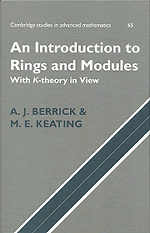Preface
Published online by Cambridge University Press: 12 October 2018
Summary
This text is an introduction to the theory of rings and modules for a new graduate student. What gives this book its special flavour is that it is particularly aimed at someone who intends to move on to study algebraic if-theory. This aim influences both the choice of rings and modules that we discuss, and the manner in which we discuss them.
Starting from a knowledge of undergraduate linear algebra together with some elementary properties of the integers, polynomials and matrices, we provide the basic definitions and methods of construction for rings and modules, and then we develop the structure theory for modules over various kinds of ring.
These classes of ring reflect the historical roots of algebraic K-theory in geometry and topology on the one hand, and representation theory and number theory on the other. Thus the rings that interest us are Noetherian rings, in particular skew polynomial rings, Artinian rings, and Dedekind domains. The text pursues ring and module theory up to the point where the aspiring if-theorist needs category theory. The necessary category theory is dealt with in the companion volume [BK: CM], both in the abstract and in relation to more advanced topics in the ring and module theory. Our division of the subject matter in this way means that the present volume can be regarded simply as an introduction to some fundamental topics in the theory of rings and modules.
Here is a more detailed survey of the material in this text.
The first chapter gives the definitions of rings and modules, together with some examples and constructions. The second chapter develops the groundwork of the theory of modules, with a particular emphasis on the basic ways of constructing and comparing modules. We see how to combine modules to make new ones, using direct sums and, more generally, short exact sequences. The use of short exact sequences to describe the relationships between mod ules lies at the core of algebraic K-theory, and so the notion of a short exact sequence plays a central role both in this text and in [BK: CM]. Also crucial to if-theory are the free modules, which are assembled by taking direct sums of copies of a ring, and the projective modules, which arise when free modules are in turn split up into direct sums.
- Type
- Chapter
- Information
- An Introduction to Rings and Modules , pp. xiii - xviPublisher: Cambridge University PressPrint publication year: 2000



